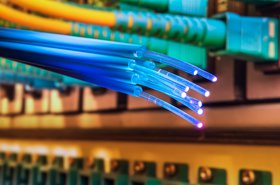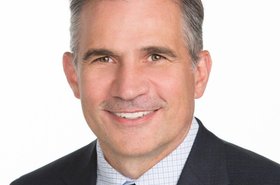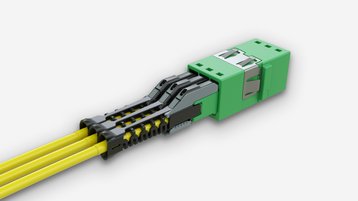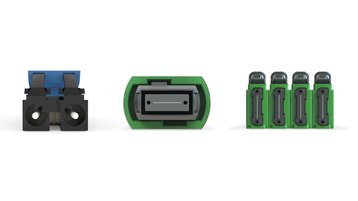The sheer quantity of data being passed through the world’s data centers was already rising at an exponential rate, and now, the dawn of everyday artificial intelligence (AI), has seen that acceleration has grown even faster with high-compute loads making for an increasing proportion of the strain on facilities and networks.
Are data centers ready? With hyperscalers already moving to fiber-dense networks capable of running at 800G (800Gbps), aided by faster transceivers, denser optical cables and the latest Very Small Form Factor (VSFF) interconnects, DCD spoke to Corning’s head of development for data centers, Michael Crook, about why data center operators need to be thinking about their fiber.
Corning is a stalwart of the fiber optic industry, and as such, Crook is perfectly placed to tell us what the new generation of cables with VSFF connectors can do to future-proof data centers for the AI revolution.
We start with the fundamentals. What exactly is a VSFF? Crook puts it in a nutshell for us:
“VSFF stands for ‘very small form factor connector – a category of connectors with multiple fibers, in a small package, providing better density for infrastructure cabling systems, along with other benefits like faster deployment speed.”
These VSFF connectors are usually found alongside increasingly dense optical cables, the result of shrinking the diameter of each individual fiber. The most current optical fiber has a diameter of just 250 microns, but as Crook explains, that was yesterday. This is tomorrow:
“What we see from the market is a need for a smaller fiber that allows us to get more cables into an equipment rack and provide more interconnects for our customers. We just introduced the 200-micron fiber – thinner than a strand of hair.”
He continues by explaining how customer needs have fuelled this innovation:
“Customers are talking more and more about fiber strands in their equipment racks. There are hundreds or even thousands of fibers in an equipment rack. You can achieve that by increasing the density of the fiber strands in the cable, but now there is an accelerated need for even more density, which, in turn, will motivate our development cycles.”
The cables themselves are only half the story. An efficient AI-enabled data center will still need a greater number of these cables, arranged in a spine and leaf formation, and expanded by breakout switches.
The advent of VSFF reduces the amount of physical space required for each node, increasing capacity and reducing latency. Crook explains the difference between the old ways and the new:
“Historically, data center operators have used two-fiber or LC duplex fiber connections. That was good for data rate speeds up to 100Gb, but as you get into 800Gb and beyond, that requires a multi-fiber connection. Several optical transceivers on the market accept a multifiber interface in the embodiment of an MPO or an MTP connector.
Indeed, many existing infrastructures are already operating on equipment that can accept VSFF connectors, but installed in a traditional duplex formation. Crook goes on to explain why a structured cabling plan will maximize that existing equipment, starting with a significant reduction in footprint:
“As densities increase, a 12-fiber MTP connector has the same footprint as an LC duplex connector. There’s the fiber density, but with VSFF connectors, you triple the capacity of an MTP connector. Compared with an LC duplex footprint, three VSFF connectors can have up to 24 fibers each – 72 fibers versus two in that same footprint.”
For many of the world’s hyperscalers, the move to 800G and VSFF has been urgent and necessary to keep up with the intense demands of the AI-enabled worlds.
Consumer applications such as ChatGPT and Google Gemini simply couldn’t exist without bleeding-edge interconnects in their data centers. However, now it is time for every data center to question if it’s time for them to follow suit:
“Hyperscalers – your larger cloud operators are upgrading now – ramping up and designing their new facilities around various small form factor connectors and we're ramping up our manufacturing capability to support this demand. Generally, innovations and upgrades happen with the hyperscalers first, then migrate to smaller data center operators.”
But, we ask Crook, if you’re not urgently in need of AI workload provision yet, are there any advantages you can tell us about that an upgraded data center would see on Day One?
“Density and speed of deployment are the main things. Certainly, if you think you're going to have future fiber connectivity needs in a given space, considering VSFF connectors now could be a good solution because more and more structured cabling solutions are coming into the market than two or three years ago.”
He goes on to point out that, as well as the operational advantages, moving to VSFF is designed to be deployed at speed – ideal for a live data center environment:
“Even if your AI or high-compute applications are planned for the future, you need to get networks up and running quickly. If you can utilize pre-connectorized solutions, some of the VSFF connectors are designed so they can't be mis-installed, which can help remove any risk in the system and speed up these deployments.”
There’s clear evidence emerging that the demand for AI workloads is already spreading beyond the hyperscalers:
“We see that hyperscalers are consuming a lot of GPUs, but there's a pretty large percentage of the GPUs that are shipping that are not going to hyperscalers. These could be going to smaller cloud providers or their enterprise customers as they start to build out networks to support these compute architectures.”
The temptation could be there to try a “piecemeal” approach involving updating individual racks to VSFF as workload dictates. However, Crook points out that while this is a good approach from a budgeting standpoint, it also brings multiple connector types into play, and that makes ongoing maintenance more of a headache:
“Customers don't like using lots of different types of connectors in their data center environment. You have different design requirements, different connectors, and different spares. If they can standardize using one type of connector that satisfies most use cases, data center customers would prefer that, because it gives them a bit more flexibility.”
Although the benefits are tangible, the sheer quantity of cabling and VSFF required to upgrade a data center to a fully AI-enabled spine-and-leaf architecture is an imposing proposition, and that’s why companies like Corning are keen to work with data center operators to ensure project success.
As the industry grows more collaborative, and less proprietary, choosing the right partner can open up a wide world of products from across the marketplace. Crook tells us why people choose Corning as their partner for fiber network upgrades:
“Customers come to Corning because we've got the knowledge, quality, innovation, pipeline, and scale to meet their bill of plans and support that in the future. It requires collaboration with industry peers, even some organizations that we historically competed with. We're not averse to doing that, because we take those cues from our customers.”
Any of us working in the technology sector know that progress never stops, and Crook tells us that work is well underway on the next innovation in increasing fiber density:
“We're constantly innovating. We’re discovering ways to utilize smaller connectors to get more density for our customers. Right now, we see a lot of 400-800Gb deployments. Some of these operators are currently trialing 1.6Tb and looking at what their requirements will be in the future.”
While not even the hyperscalers are ready for the move to 1.6Tb, the moral of the story is clear. Your rivals could well be in the throws of preparing for the AI revolution. Are you? And if not, why not?
Click here to learn more about groundbreaking MMC innovations!
More from Corning
-

Sponsored Five questions to consider when building your data center migration strategy
Ensuring a flexible and cost-effective strategy for 400G and 800G transceivers with these critical considerations
-

Sponsored Intelligent structured cabling will future-proof the age of AI
AI has made 800G an aspiration, not a nice to have
-

Sponsored How optical innovation is helping data centers prepare for artificial intelligence
Meeting the requirements of an AI enabled data center



